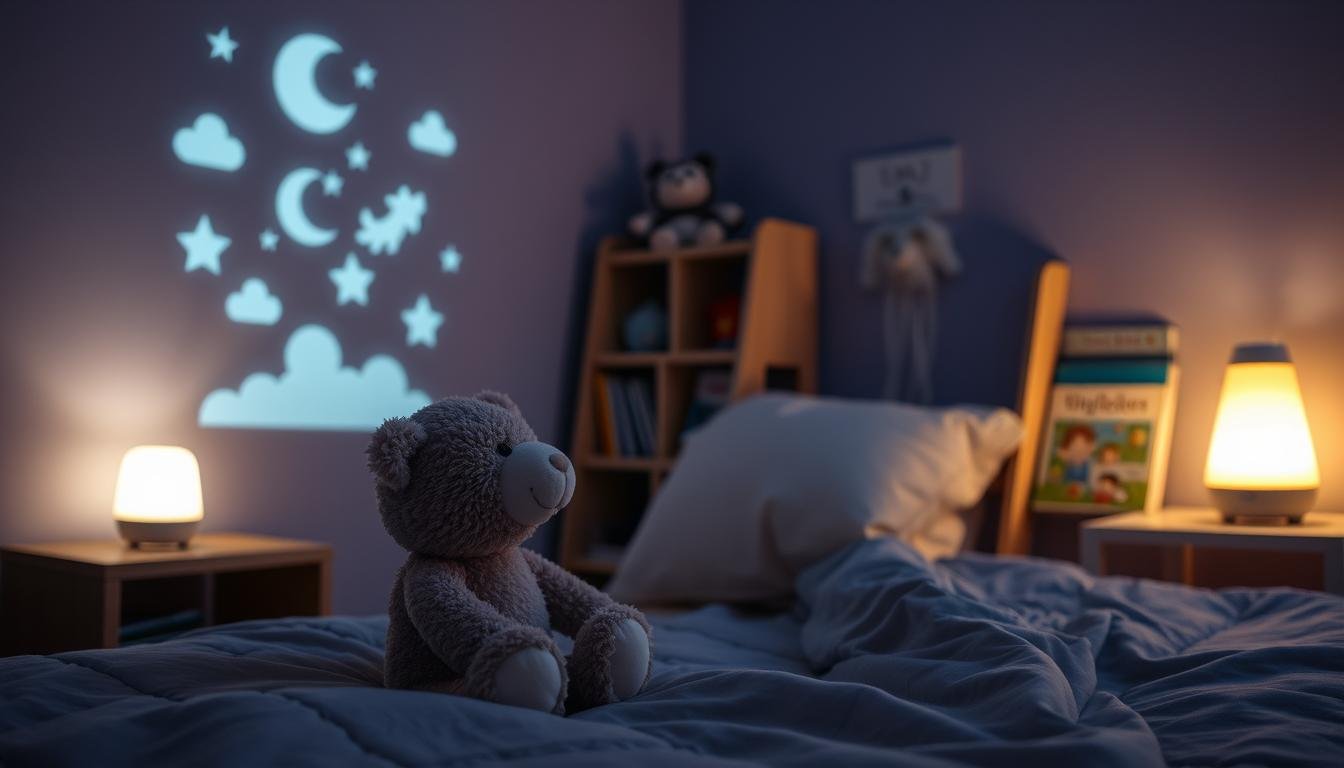Did you know that 20-30% of children experience difficulties when it comes to bedtime? As a parent, ensuring your little ones get the rest they need can feel like a daily challenge. But with so many options available, how do you know what’s safe and effective?
From establishing a consistent bedtime routine to exploring natural supplements like melatonin, there are numerous ways to help your child rest better. However, with growing concerns about safety and the FDA’s lack of regulation for supplements, it’s crucial to make informed decisions.
This article dives into evidence-based strategies and products like Unisom Simple Slumbers® and Hiya, while emphasizing the importance of consulting a doctor before trying any solutions. Let’s explore how you can create a safe and effective plan for your child’s restful nights.
Key Takeaways
- 20-30% of children face bedtime challenges.
- A consistent bedtime routine can make a big difference.
- Melatonin is a popular option but requires caution.
- Always consult a doctor before using supplements.
- Combining behavioral strategies with supplements works best.
Understanding Sleep Challenges in Children
Many parents notice their children struggling with bedtime routines. These challenges can range from difficulty falling asleep to frequent waking during the night. Understanding the root causes is the first step toward finding effective solutions.
Common Rest Issues in Young Ones
Children may experience various rest-related problems, such as insomnia, night terrors, or sleep apnea. These issues can disrupt their daily lives and affect their overall health. Conditions like ADHD or autism spectrum disorders often increase the likelihood of these challenges.
Screen time before bed can also interfere with their natural circadian rhythms. The blue light from devices delays the release of melatonin, making it harder for them to wind down. Establishing a consistent bedtime routine can help mitigate these effects.
Why Rest Is Vital for Development
Rest plays a critical role in a child‘s growth and development. During the night, the body produces growth hormones essential for physical development. Additionally, the brain processes information and forms memories, which are crucial for cognitive function.
Chronic rest deprivation can lead to issues like irritability, poor academic performance, and weakened immunity. Ensuring children get the recommended hours of rest for their age group is vital. For example, toddlers need 11-14 hours, while school-aged children require 9-12 hours.
By addressing rest challenges early, parents can set the foundation for better health and well-being. Simple changes, like reducing screen time and creating a calming bedtime environment, can make a significant difference.
What Are Sleep Aids for Kids?
Parents often wonder if certain products can help their child rest better. These solutions are designed to support relaxation and improve nighttime routines. However, it’s essential to understand their purpose and when they might be appropriate.
Definition and Purpose of Sleep Aids
These products fall into two main categories: supplements and medications. Supplements, like melatonin, are not regulated by the FDA, while medications require a prescription. Their primary goal is to assist with temporary challenges, such as jet lag or adjusting to a new schedule.
Dr. Adavadkar emphasizes, “These should never be a first-line treatment.” Behavioral strategies, like consistent routines, should always come first. Unisom, for example, warns against using their product for more than two weeks without consulting a professional.
When to Consider Sleep Aids for Children
These supplements might be considered when behavioral methods don’t work. For instance, occasional issues like travel disruptions or short-term stress could warrant their use. However, chronic problems often require diagnostic testing and professional intervention.
Red flags, such as prolonged restlessness or frequent waking, should prompt a visit to a pediatrician. The CDC reports a 530% increase in pediatric melatonin ingestions, highlighting the need for caution. Always consult a doctor before introducing any new supplement or medication.
Melatonin: A Popular Sleep Aid for Kids
Melatonin has become a go-to solution for parents seeking help with their child’s rest. This naturally occurring hormone plays a key role in regulating the sleep-wake cycle, helping the body know when it’s time to wind down. However, understanding how it works and its potential risks is essential before use.
How Melatonin Works in Children
Melatonin is produced by the brain in response to darkness, signaling that it’s time to fall asleep. In children, this process can sometimes be disrupted by factors like screen time or irregular schedules. Supplements can help reset this cycle, especially during travel or transitions.
Children metabolize melatonin differently than adults, often requiring smaller doses. Studies suggest that starting with 0.5-2mg is effective for most kids. However, delayed-release formulations may be better for those who wake up frequently during the night.
Benefits and Potential Risks of Melatonin
Melatonin offers several benefits, including improved brain health and better rest patterns. It’s particularly helpful for children with ADHD or autism, as research shows it can reduce restlessness and improve focus.
However, there are risks to consider. Unregulated products may contain contaminants, and long-term use could impact development. The CDC reports a significant rise in emergency room visits due to accidental overdoses, highlighting the need for caution.
Recommended Dosage and Safety Guidelines
For children, a starting dose of 1-2mg is generally safe. Brands like Unisom offer 0.5mg gummies, which are easy to administer. Always consult a pediatrician before use, especially for long-term concerns.
Alternatives like Hiya’s melatonin-free approach can also be effective. Their focus on natural ingredients provides a safer option for parents wary of supplements. Remember, behavioral strategies should always come first.
Natural Supplements for Better Sleep
Exploring natural solutions can be a game-changer for parents looking to improve their child’s nighttime routine. Plant-based ingredients like chamomile and valerian have been used for centuries to promote relaxation. These options are often seen as gentler alternatives to synthetic products.
Chamomile, for example, is known for its calming properties. Studies show it can help reduce restlessness and improve overall comfort. Valerian root, on the other hand, is often used to help support a more consistent routine. However, it’s essential to choose products with clear labeling and third-party testing.
Effectiveness and Safety Considerations
When selecting natural supplements, safety is a top priority. Some products, like kava, have been linked to liver damage and should be avoided. Brands like Hiya use a blend of L-theanine, GABA, and chamomile, which are generally considered safe and non-habit forming.
Magnesium and vitamin B6, found in Hiya’s formula, work together to promote relaxation. Monk fruit is used as a sweetener, making it a sugar-free option. Always check for certifications like NSF or ConsumerLab to ensure quality and compliance with safety standards.
How to Choose the Right Natural Supplement
Start by evaluating the ingredients and their dosages. Look for products that are free from artificial additives and have undergone third-party testing. Hiya’s Prop 65 compliance is a good example of a brand prioritizing safety.
Consider the delivery system as well. Gummies are often easier for children to take, while tablets may offer a more concentrated dose. Always consult a pediatrician before introducing any new supplement to ensure it’s appropriate for your child’s needs.
By focusing on natural, non-habit forming options, parents can help their children achieve a good night’s rest without unnecessary risks. Combining these supplements with behavioral strategies often yields the best results.
Prescription and Over-the-Counter Sleep Medications
Navigating the world of sleep medications for children can be complex and overwhelming for parents. Understanding the regulations, risks, and appropriate usage is essential to ensure safety and effectiveness.
FDA Regulations on Sleep Medications for Kids
The Food Drug Administration (FDA) strictly regulates the use of medications for children. Over-the-counter (OTC) options are prohibited for those under 16, and certain ingredients are banned for pediatric use. For example, diphenhydramine and doxylamine are not recommended for children under 5.
Black box warnings are required for some medications, highlighting severe risks like rebound insomnia. Brands like Unisom recommend their products only for children aged 4 and above. Always check labels and consult a child doctor before use.
Potential Side Effects and Risks
Using sleep medications can lead to side effects such as daytime sleepiness, dizziness, or agitation. Rebound insomnia is another concern, where symptoms worsen after stopping the medication. Antihistamines, like diphenhydramine, can cause drowsiness but may not address the root cause of rest issues.
Prescription medications, though rare, are sometimes used for severe cases. These require a detailed evaluation by a pediatrician and strict adherence to dosage guidelines. Interactions with other medications must also be considered to avoid complications.
When to Consult a Pediatrician
If behavioral strategies and natural supplements don’t work, it may be time to consult a child doctor. Red flags like prolonged restlessness, frequent waking, or emergency symptoms such as difficulty breathing warrant immediate attention.
The American Academy of Pediatrics (AAP) advises against the routine use of medications for rest issues. Instead, they recommend a combination of behavioral strategies and professional guidance. Always follow the drug administration guidelines provided by your pediatrician to ensure safety.
Behavioral Strategies to Improve Sleep
Behavioral strategies are key to improving nighttime routines. These methods focus on creating habits and environments that encourage relaxation and consistency. By addressing the root causes of restlessness, parents can help their children fall asleep more easily and stay asleep longer.
Establishing a Consistent Bedtime Routine
A consistent bedtime routine is one of the most effective ways to improve night sleep. Start with a 30-minute wind-down period that includes calming activities like reading or listening to soft music. This signals to the body that it’s time to relax and prepare for rest.
Hiya suggests screen-free activities like coloring or storytelling to help get children into the right mindset. Avoid stimulating activities or bright lights, as these can interfere with the body’s natural rhythms. Consistency is key—stick to the same schedule every night, even on weekends.
Creating a Sleep-Friendly Environment
The bedroom environment plays a crucial role in promoting night sleep. Keep the room cool, ideally between 68-72°F, and use blackout curtains to block out light. A night light with a warm color temperature (under 3000K) can provide comfort without disrupting melatonin production.
White noise machines or apps can mask disruptive sounds, helping children fall asleep faster. Pink noise, which has a deeper tone, may be even more effective for some. Ensure the bed is comfortable and free of distractions like toys or electronics.
Techniques to Reduce Sleep Resistance
If your child resists bedtime, try the “bedtime fading” technique. Gradually shift their bedtime earlier by 15 minutes each night until you reach the desired time. This helps align their internal clock with the new schedule.
Stimulus control methods, like only using the bed for sleep, can also be effective. If your child wakes up, gently guide them back to bed without engaging in lengthy conversations. Gradual parent withdrawal, where you slowly reduce your presence in the room, can help build independence.
For younger children, a favorite stuffed animal can provide comfort. Ensure it’s safe and age-appropriate. Adjust nap schedules based on age—toddlers may need one nap, while older children may not need naps at all.
When to Seek Professional Help
Persistent nighttime issues may signal deeper concerns that require expert attention. While many challenges can be addressed with routines and natural remedies, some situations demand professional intervention. Recognizing the signs early can lead to safe effective solutions and better outcomes for your child.
Signs of Underlying Sleep Disorders
Certain behaviors may indicate underlying disorders. Frequent snoring, gasping for air, or pauses in breathing could point to sleep apnea. Restless leg syndrome, characterized by an irresistible urge to move the legs, can also disrupt rest. Polysomnography, a detailed sleep study, is often used to diagnose these conditions.
Other red flags include sleepwalking, night terrors, or injuries during the night. These issues not only affect nighttime routines but can also impact your child’s day-to-day functioning. If you notice these signs, it’s time to consult a pediatrician.
How Pediatricians Can Help
Pediatricians play a crucial role in identifying and managing nighttime concerns. They may recommend actigraphy, a home monitoring method, to track sleep patterns. For more complex cases, they might refer families to a sleep clinic for further evaluation.
Insurance coverage for these services varies, so it’s essential to discuss options with your provider. Pediatricians can also help manage comorbid conditions, such as ADHD or anxiety, which often exacerbate nighttime issues.
The Role of Sleep Specialists
When standard treatments don’t work, sleep specialists step in. Certified by the American Academy of Sleep Medicine (AASM), these experts use advanced tools to diagnose and treat complex disorders. They can provide tailored plans that address both behavioral and medical aspects.
Before your visit, prepare a list of questions to ensure you cover all concerns. This will help the specialist understand your child’s unique needs and recommend the most appropriate interventions. With the right support, you can create a safe effective plan for your child’s well-being.
Conclusion
Creating a balanced approach to nighttime routines can make a significant difference in your child’s health. Start with behavioral strategies, such as consistent schedules and calming activities. If needed, consider natural products like Hiya, which offers a 50% discount on first orders. For more persistent issues, consult a professional before exploring medications.
Unisom and Hiya take different approaches—Unisom provides a money-back guarantee, while Hiya focuses on nutritional synergy. Always prioritize safety and avoid quick fixes. In emergencies, contact Poison Control or refer to ongoing clinical trials for the latest research.
Remember, every child’s body is unique. Use tools like a downloadable sleep diary to track progress. With patience and the right strategies, you can empower your family to enjoy restful nights and brighter days.
FAQ
What are common sleep problems in children?
Children often face issues like difficulty falling asleep, frequent waking, or daytime sleepiness. These can stem from stress, irregular routines, or underlying health conditions.
Why is sleep important for child development?
Proper rest supports brain health, emotional well-being, and physical growth. It helps kids focus, learn, and stay active during the day.
When should parents consider using sleep aids for their child?
Sleep aids may be an option if behavioral strategies don’t work and the child struggles with persistent sleep issues. Always consult a pediatrician first.
How does melatonin work in children?
Melatonin is a hormone that regulates the sleep-wake cycle. It can help kids fall asleep faster, especially if their natural rhythm is disrupted.
Are natural supplements like chamomile safe for kids?
Many natural supplements, such as chamomile, are considered safe when used correctly. However, it’s best to check with a healthcare provider before starting any new product.
What are the risks of prescription sleep medications for children?
Prescription medications can have side effects like drowsiness or dependency. They should only be used under a doctor’s supervision and as a last resort.
How can a bedtime routine help improve sleep?
A consistent routine signals to the body that it’s time to wind down. Activities like reading or a warm bath can make it easier for kids to fall asleep.
When should parents seek professional help for their child’s sleep issues?
If sleep problems persist, affect daily life, or include symptoms like snoring or restlessness, consult a pediatrician or sleep specialist for further evaluation.









